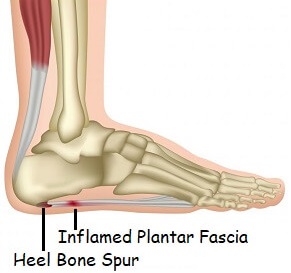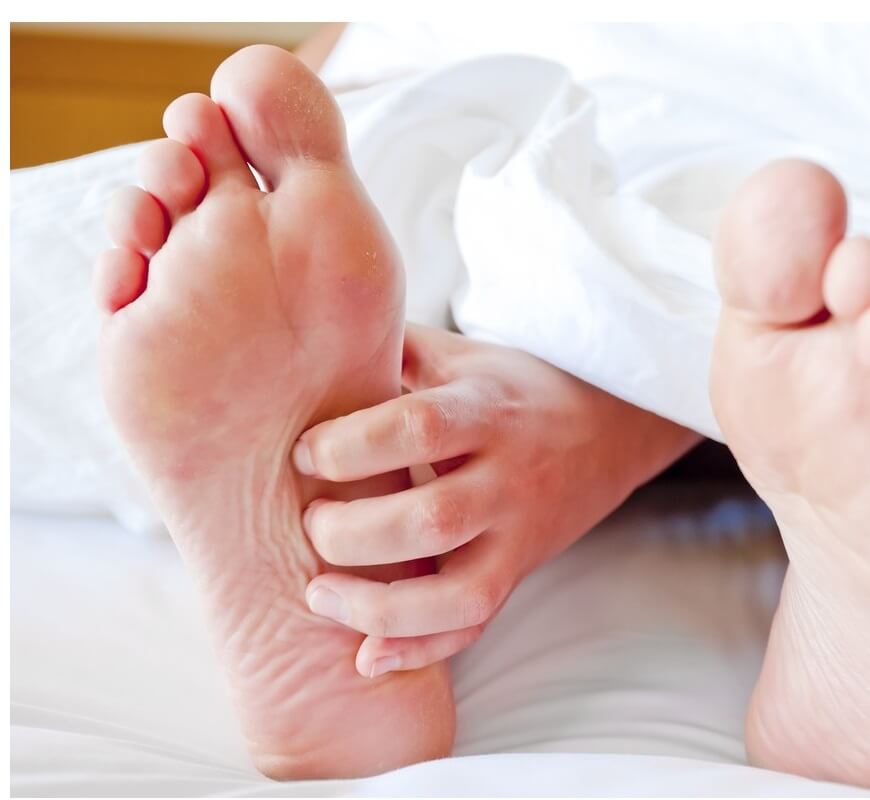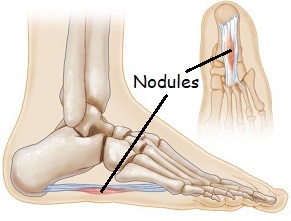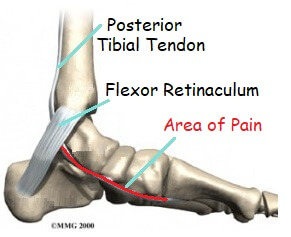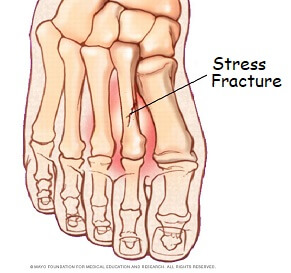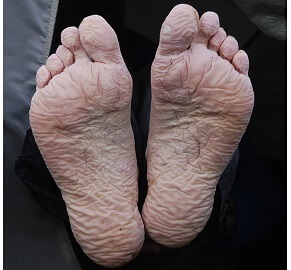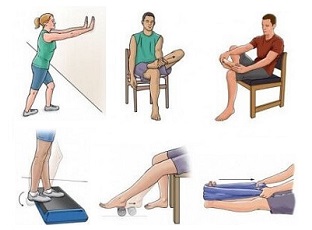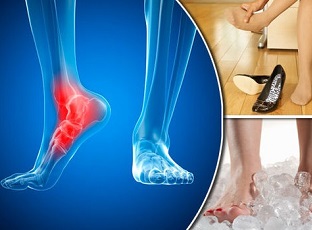- Home
- Diagnosis Guide
- Foot Arch Pain
Foot Arch Pain
Written By: Chloe Wilson BSc(Hons) Physiotherapy
Reviewed By: FPE Medical Review Board
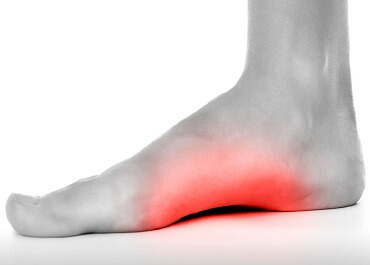
Foot arch pain is a common problem, largely due to the amount of pressure going through our feet, especially if you are on your feet a lot.
This is because the muscles and tendons that support the foot arches have to work hard to stabilise the foot and can quickly fatigue resulting in pain on the bottom of the foot.
Weakness and tightness in the foot muscles changes how the forces go through the feet and up the legs so foot arch pain is often associated with back and knee pain too. There may also be lumps and bumps underneath the foot.
There are a number of different things that cause bottom of foot pain, and pain under the foot arch is common in athletes, particularly those who like to push themselves to their limit.
Common Causes of Foot Arch Pain
So let's look at the most common causes of pain in the foot arches, and how they present, then we'll find out more about how to treat them. If your pain is slightly further forwards in the ball of the foot rather than the arch of the foot, then check out the Ball Of Foot Pain article.
1. Plantar Fasciitis
The most common cause of foot arch pain is plantar fasciitis. This is where there is damage to the thick band of tissue that runs under the foot.
Plantar fasciitis usually develops due to altered foot biomechanics, bone spurs and muscle tightness and often affects people who spend long periods on feet or suddenly increase their activity levels.
Typical symptoms of plantar fasciitis are foot arch pain near the heel that is worse in the morning and with initial movement. The pain under the foot arch usually improves as you get going but will get worse again with too much activity.
You can find out all about the common causes, symptoms and treatment options of this common cause of foot arch pain in the Plantar Fasciitis section.
2. Foot Cramps
Another common cause of foot arch pain is cramp. Foot cramps affect around 25% of people over the age of 60, particularly at night.
Foot arch cramps are sudden, uncontrollable, intense muscle spasms lasting anywhere from a few seconds to several hours. They result in sharp, intense calf, toe or foot arch pain, muscle spasm and even toe curling.
Cramps in the foot arch may be caused by dehydration, lack of vitamins & minerals, muscle tightness, fatigue, nerve damage or poor circulation.
You can find out all about the common causes, symptoms and treatment options as well as how to prevent foot arch pain from cramp in the Foot Cramps section.
3. Tarsal Tunnel Syndrome
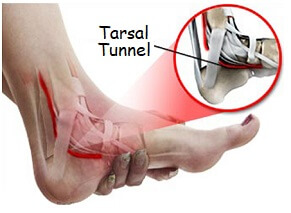
Tarsal tunnel syndrome is one of the less common causes of inner foot arch pain caused by pressure on the tibial nerve as it passes through the tarsal tunnel
Anything abnormal that takes up space in the tarsal tunnel e.g. bone spurs, swelling, cysts will compress the nerve and cause pain in the bottom of the foot.
Typical symptoms of tarsal tunnel syndrome include inner arch foot pain, pins & needles and numbness.
Find out all about the causes, symptoms and treatment options for this type of bottom of foot pain in the Tarsal Tunnel Syndrome section.
4. Plantar Fibromatosis
Another possible cause of pain under the foot arch is plantar fibromatosis, a condition where small nodules develop in the plantar fascia, usually in the middle of the foot arch.
Plantar fibromatosis may develop due to a foot injury, genetics or various medical conditions.
Typical symptoms of plantar fibromatosis include a small, firm lump in the arch of the foot, toe curling and pain in arch of foot with any pressure over the nodules. Plantar fibromas are one of the most common causes of lumps on the bottom of the foot.
Find out all about the common causes, symptoms and treatment options for this cause of pain in the bottom of the foot in the Plantar Fibromatosis section.
5. Posterior Tibial Tendonitis
Inner foot arch pain is often due to inflammation and degeneration of the posterior tibialis tendon, known as tibialis posterior tendonitis. Tibialis posterior is an important muscle and its tendon plays a vital role in supporting the foot arches.
Tibialis posterior tendonitis tends to develop from overuse during high impact activities e.g. tennis or soccer, or following an injury e.g. a fall.
Typical symptoms of posterior tibial tendonitis are pain in the arch of the foot and around the ankle, collapsing of the medial foot arch and an inability to stand on tiptoes.
You can find out this common cause of pain in the foot arch in the Posterior Tibial Tendonitis section.
6. Stress Fractures
Stress fractures, tiny breaks in one or more of the foot bones, can cause sharp pain in the arch of the foot.
Stress fractures are usually caused by repetitive overloading of the foot bones from high-impact activities e.g. running & jumping and often develop when suddenly increasing training levels.
Stress fractures typically cause localised foot arch pain around the fracture site with associated bruising and swelling. Pain in the bottom of the foot often causing difficulty walking.
Find out all about the common causes, symptoms and treatment options for severe arch pain in the Foot Stress Fractures section.
7. Accessory Navicular Syndrome
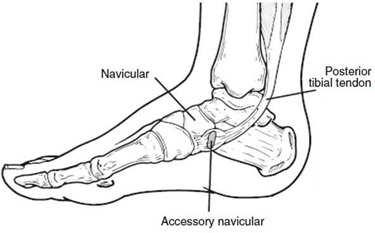
A common cause of foot arch pain associated with a lump on the inner arch is accessory navicular syndrome.
Around 10% of the population are born with a small extra bone in their inner foot arch, known as an accessory navicular.
Often, this extra piece of bone doesn't cause any problems but if it gets irritated and inflamed, it will cause inflammation and inner foot arch pain. There may be a visible bony lump that can rub on shoes causing pain and making walking uncomfortable.
You can find out all about how it causes medial foot arch pain and how to treat it in the Accessory Navicular Syndrome section.
8. Flat Feet
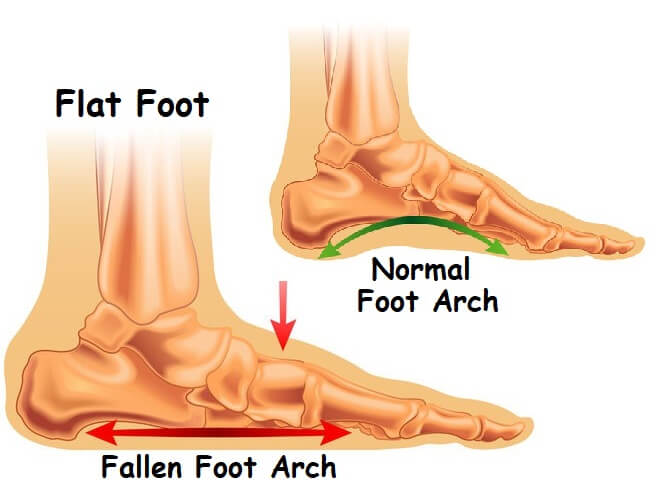
People with flat foot often develop inner foot arch pain. Flat feet develop when the foot arches collapse causing the sole of the foot to drop down. Around 30% of people have flat feet.
Some people are born with flat feet but they can also develop during pregnancy, after a foot injury, when there is excessive stress on feet or as we age.
Fallen foot arches may cause fatigue in feet, pain in arch of foot, back pain and knee pain, cramps in the foot arch and can make it difficult to push up onto your tiptoes which can affect how you walk.
Wearing specially designed orthotics e.g. arch supports can really help to reduce pain in the bottom of the foot from fallen arches.
9. Trench Foot
Trench foot tends to cause pain on the bottom of both feet. Also known as Immersion Foot, trench foot is caused by tissue & nerve damage due to reduced blood flow to the feet.
Trench foot develops with prolonged exposure to damp conditions, poor foot hygiene and sweaty feet and typically affects hikers, festival-goers & runners.
Common symptoms of trench foot include swollen, white/grey feet, prickly pain under foot arch, numbness, pins and needles, blistering and possible gangrene if left untreated.
Find out all about the common causes, symptoms and treatment options, including which celebrities have suffered from it, in the Trench Foot section.
Other Possible Causes Of Pain In Arch Of Foot
Other possible causes of foot arch pain include:
- Cuboid Syndrome: where one of the small foot bones shifts out of place, often from an ankle sprain. This is a common cause of ongoing outside bottom of foot pain
- Peroneal Tendonitis: inflammation of one of the tendons causing outside foot arch pain, although the pain may not always extend into the bottom of the foot
- Bone Spurs: hard outgrowths of bone that develop in response to irritation. They typically cause pain in the bottom of the foot, particularly towards the heel
- Foot Lumps: there are a number of conditions that can cause a lump in the arch of the foot that may result in bottom of foot pain
- Metatarsalgia: irritation and inflammation underneath the metatarsal heads can lead to ball of foot pain
- Plantar Warts: small, rough growths often containing tiny black dots are common on the bottom of the foot
What Are The Arches of The Foot?
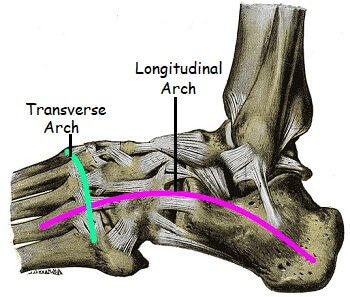
There are twenty-six bones in the foot.
The tarsal and metatarsal bones fit together in the middle of the foot and are supported by various ligaments, muscles and tendons to form the foot arches.
The arches of the foot support the foot and control how the forces associated with activities like walking are transferred up and down the leg.
There are two main arches in the foot, the longitudinal arch (indicated in pink on the diagram) which runs down the length of the foot , and the transverse arch (indicated in green) which runs across the width of the foot.
The
longitudinal arch can be split into two:
- Medial Longitudinal Arch: the higher of the two found in the inner side of the foot
- Lateral Longitudinal Arch: found on the outer side of the foot
Anything which affects the position of the arches can lead to foot arch pain and discomfort on the bottom of the foot.
Foot Arch Pain Treatment
Treatment for foot arch pain will depend on what is causing the pain on the bottom of the foot. Typical treatment for pain under the foot arch includes:
- Stretches: to reduce the tension in the muscles can really help to reduce cramps and pain in foot arches, particularly if you get morning foot pain
- Strengthening Exercises: to improve the strength, stability and endurance of the foot muscles helps to support the foot arches and thus reduce pain
- Ice: Regular use of ice packs, or placing a frozen bottle of water under your foot helps to reduce pain under foot arch and swelling - 10 mins max per application
- Orthotics: Special inserts for your shoes to correct foot position and support painful foot arches
- Toe Stretchers: handy little devices to help stretch out the toes and the bottom of the feet which can really reduce foot pain in arches
- Foot Rollers: Simply roll your feet over these as you relax to ease your foot arch pain
You can find out more about specific treatment for each different cause of pain on the bottom of the foot by reading the full articles for each condition.
Footwear & Bottom Of Foot Pain
It sounds simple but footwear plays an extremely important role in how our feet feel. Foot arch pain is often caused by ill-fitting shoes, especially ones with little arch support or that are too tight.
So one of the best ways to reduce or avoid bottom is foot pain is to wear the right shoes. Footwear is particularly important if you are going to be spending long periods on your feet or for sporting activities such as running. Shoes should be supportive, comfortable, cushioned, provide the appropriate level of arch support and be the correct width.
It can also help to go bare foot when you can to reduce the amount of pressure and friction through the feet and thus reduce pain in the foot arch.
Foot Arch Pain Summary
The most common causes of foot arch pain are plantar fasciitis, plantar fibromatosis, tendonitis, stress fractures and foot cramps.
Outside bottom of foot pain is typically caused by cuboid syndrome or peroneal tendonitis.
Inner arch foot pain may be caused by tarsal tunnel syndrome, posterior tibial tendonitis, accessory navicular syndrome or fallen foot arches.
A lump in the arch of the foot is typically caused by a mortons neuroma, plantar fibroma, bone spur, accessory navicular, plantar wart or charcot-marie-tooth disease. You can find out more in the Bump On Bottom Of Foot section.
Sharp pain in the foot arch is usually due to a stress fracture, metatarsalgia or tendonitis.
Bottom of foot pain is usually caused by intense exercise, wearing tight shoes or underlying medical conditions. Sometimes the pain is more in the ball of the foot rather than the foot arches - find out more in the Ball Of Foot Pain article.
Foot arch pain is a common problem, particularly among athletes who like to push themselves.
Treatment for foot arch pain usually consists of a combination of strengthening and stretching exercises, changing your footwear, orthotics, rest, medication and ice.
What Else Can Help?
If none of these is sound quite like your foot arch pain and you want some help working out what is wrong, visit the foot pain diagnosis section.
Alternatively, if you have other symptoms as well as pain, such as foot swelling, a rash or numbness, in the foot pain symptoms section we'll help you to identify what is going on and what you can do about it. Or if you have any lumps or bumps under your foot, check out the Bump On Bottom Of Foot article.
So don't let foot arch pain get you down, take back control today.
You may also be interested in the following articles:
- Pain On Top Of Foot
- Ball Of Foot Pain
- Outer Side Of Foot Pain
- Inner Side Of Foot Pain
- Nerve Pain In The Foot
- Swollen Feet & Ankles
- Foot Numbness
- Burning Foot Pain
Related Articles
Page Last Updated: 20th November, 2024
Next Review Due: 20th November, 2026
